How To Repair Holes On The Wall
How to Repair Large Wall Holes
The method on this page tin be used to patch holes of up to a square foot or and so and down to a few inches. This will work on drywall and plaster walls but not on ceilings. The patch would sag if used on a ceiling causing a burl in the finished repair. Try the method at this link to repair big holes in ceilings. Check here for a video demonstrating how to repair large holes in walls.
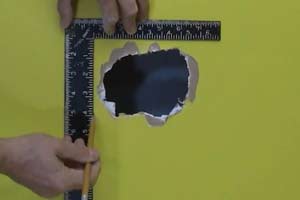
Place a pencil mark about ½inch from the top, bottom, and both sides of the hole. Concord a framing square along ii marks at a time to draw a square around the pigsty in the wall.
Cut Out the Square Hole
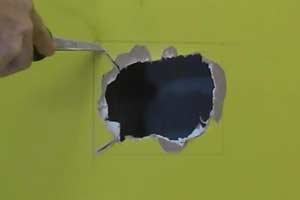
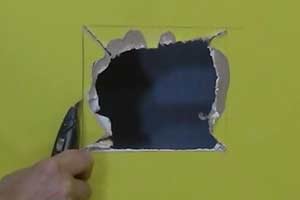
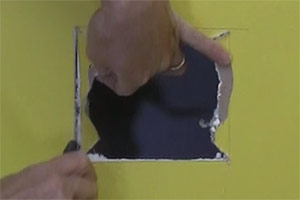
Cutting from the eye of the hole, out to each corner of the square using a drywall saw on wallboard. Don't try to cut forest-lath plaster like this. Only break the putty glaze off the lath using the scoring technique in the side by side step.
Score the sides of the square around the hole on wallboard using a utility knife. With wood-lath plaster, employ the side of a precipitous chisel to score several times along each side of the square.
With drywall, break the pieces off along each side of the square. Button in on the gypsum board to snap it forth the score line and then cut the backing paper to remove the piece.
With wood-lath plaster, tap inside the score lines with a hammer to break the putty along each line. Interruption the putty away from the lath and so employ a minor precipitous handheld saw similar a nippon saw to gently cut the wood slats gratis.
Almost other saws won't work well hither considering they will crusade likewise much vibration in the woods lath that volition crack the surrounding plaster.
In some cases, the forest board may be left in place. Simply if the original putty glaze is not thick enough, which is usually the example, leaving the lath volition push the new patch out as well far. Because a piece of drywall will be used to fill the pigsty, it would have to be as thin equally the wall plaster coat. The only style to avoid this problem is to remove all the woods lath from the opening or use a different method to repair holes in board plaster.
Brand a Drywall Patch to Plug the Hole
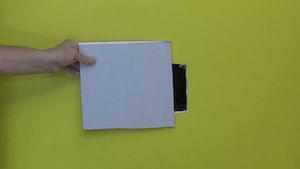
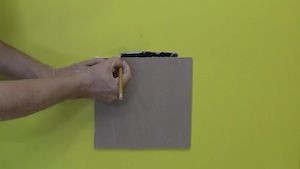
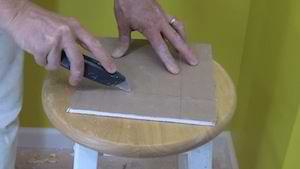
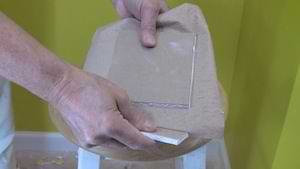
Cut a piece of drywall (any thickness) measuring ii or 3 inches larger than the squared hole along all four sides. If the hole is four inches square, so the patch should exist 8 to ten inches square.
Turn the drywall to the dorsum and concord it against the wall partially covering the hole. Marking the size of the squared hole on the back of the patch with a pencil. To brand sure the patch fits easily without forcing, mark the dimensions to be a little smaller than the opening in the wall.
Use a direct edge to join the marks on the back of the patch with a pencil line creating a hash design. Score each line with a sharp utility knife going completely across the piece of drywall.
Working from the back of the patch, snap the gypsum along each scored line. Pull the gypsum core and backing paper off the patch leaving the facing paper and centre gypsum intact. Do all iv sides to create a slice of drywall with paper "wings" around the perimeter.
Install the Patch
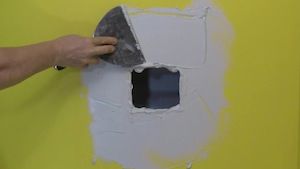
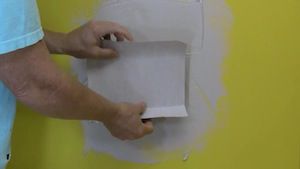
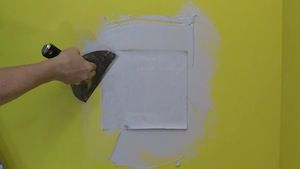
We use a 30 minute setting-blazon joint compound for the get-go few coats on this repair. The final coat is made using ready-mixed compound for easier final sanding and a smoother cease.
See the instructions for mixing and handling setting joint compound, besides called mud, and mix about a cup of the pulverization equally directed so thin it with a little more than water than recommended to ameliorate bonding with the patch.
Apply a thick coat of the mud effectually the perimeter of the hole, letting it overlap the inner edges and spread out several inches onto the wall.
Press the drywall patch into the opening and lightly printing the paper wings into the mud and so they make skillful contact all around.
Push lightly on the eye of the patch to exist sure it is seated well into the hole and level with the surrounding surface. The patch surface can exist slightly indented but don't permit it to sit above the wall level, this volition create a bulge in the finished repair.
Apply a 6 inch joint knife, held as shown, to press while stroking out from the center to clasp the excess mud from betwixt the wall and the paper wings of the patch. Piece of work around the perimeter in a radial blueprint, pressing firmly with the joint knife to clasp all but a very thin glaze of mud from under the wings. Bank check again to make sure the patch is flush with or only below the wall surface and allow the mud set.
Apply a 2d Coat of Joint Chemical compound
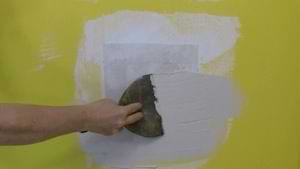
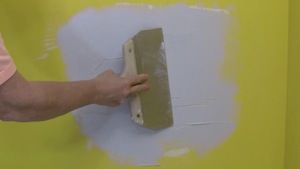
When the first glaze is dry, encompass the entire patch and surrounding wall with another thick coat of setting joint compound. Let it spread out to overlap the edges of the first coat.
With a wider joint knife, immediately skim off the excess mud to level out the patch every bit much every bit possible. Get over information technology a couple times with business firm pressure to leave a semi-smooth finish. Ignore any ridges left by the edge of the pocketknife blade.
Let the mud set until hard and shave off whatsoever ridges in the surface using an upwards stroke with the joint knife. Sand any other crude spots using medium sandpaper and wipe the grit abroad with a damp rag. If the surface has deep scratches or pits in it, utilise another coat of setting compound. If it is fairly smooth with only small flaws, keep to the final coat.
Utilise a Finish Coat
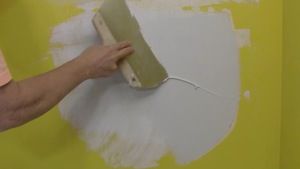
When the patch is dry, use ready-mixed joint compound to apply a concluding coat. As before, apply a thick coat commencement and so skim off the excess to get out a smooth cease. To aid level the patch, skim the mud with perpendicular strokes to the pervious coat. If you stroked horizontally with the terminal coat, stroke vertically with this one.
Sand and Bear upon Upwardly the Paint
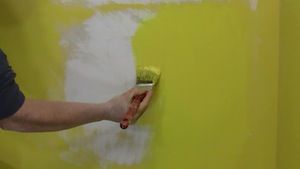
Let the final coat of joint chemical compound to dry completely and sand the repair, feathering the edges into the surrounding wall surface. Lightly wipe the dust away with a damp rag before priming and painting.
If you are using flat latex finish paint here, you can apply information technology to prime the repair. If you are using semi-gloss or other shiny pigment, prime with flat latex pigment or primer kickoff.
- How to Repair Bubbling Paint
- How to Repair Torn Drywall Paper
- Repairing Water Damaged Drywall
- Repairing H2o Damaged Plaster
- Repairing Aging Plaster
- Repairing Major Plaster Impairment
- Repairing Forest Lath Plaster
- Repairing Drywall Nail Pops
- Repairing Small-scale Wall Holes
- Repairing Big Wall Holes
- Repairing Large Ceiling Holes
- Repairing Small-scale Ceiling Holes
- Repairing Wall and Ceiling Cracks
- Repairing Cracks with Expanding Foam
- Installing a Drywall Ceiling
- Finishing Recessed Drywall Joints
- Finishing Metallic Drywall Corner Bead
- Finishing Paper Corner Dewdrop
- Finishing Inside Drywall Corners
- Finishing Drywall Butt Joints
- How to Do Drywall Texturing
- Skim Coating on Walls and Ceilings
- Sanding Drywall Articulation Compound
- Wall Tools and Materials Guide
Source: https://www.do-it-yourself-help.com/how-to-repair-large-wall-holes
Posted by: smiththoself.blogspot.com


0 Response to "How To Repair Holes On The Wall"
Post a Comment